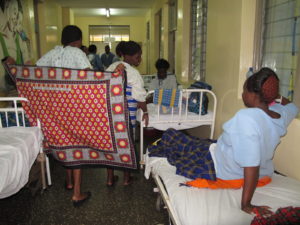By Clifford Akumu
Nairobi, Kenya: When President Uhuru Kenyatta two years ago in Kisumu launched the pilot Universal Healthcare Program, it was greeted with pomp and color.
The initiative, piloted in four counties-Machakos, Nyeri, Isiolo, and Kisumu had the sole intent of “leaving no one behind and no one should go bankrupt when they get sick.”
It was part of the government’s Big 4 Agenda that was to bear fruit by 2022. And now in its initial stages, it continues to attract many concerns.

Kisumu was identified because it leads to infectious diseases category-especially HIV/Aids and tuberculosis.
Nyeri and Isiolo counties had a high prevalence of non-communicable diseases, while Machakos recorded the highest numbers of injuries mostly from accidents.
With its ambitious target that by 2022, all people, everywhere, can access the quality health services they need-the state’s work had been cut out!
Fast forward, as the government prepares to go full throttle with the national roll-out of UHC, there are several questions and gaps that are yet to be met, say, health experts.
When she first received her Universal Health Care Card two years ago Mrs. Eunice Anyango from Kachok, Kisumu County knew her health problems had been solved, albeit for the better.
“I was assured that the money I would need for the healthcare of my three children could go to another kitty such as education,” she said.
But when she suffered from typhoid a year ago and had to be admitted and spent two months at the hospital, she came face to face with the challenges of the system.
A single mother of two and the breadwinner, she could not afford to pay the bills that had accrued to 50,000. “My relatives had to sell some livestock to raise the money” she explained
“Life has been difficult,” she added.
Sadly, says Dr. Mercy Onsando, director of Health Nongovernmental Organisations Network (HENNET), “Most of the Kenyan citizens did not understand the meaning of UHC. Others thought it was ‘free healthcare services. For example, when the pilot phase ended some citizens jokingly alluded that ‘UHC is over.’

But that is far from the truth, for starters, UHC is a global commitment to have all individuals and communities receive the health services they need without suffering financial hardship.
In February 2013, a World Bank report indicated that Kenya is among 22 developing countries that have improved efforts to achieve UHC for its citizens. The report noted that the country was among three African countries that “have significantly expanded access to healthcare in the last decade”.
According to the World Health Organisation (WHO), about 100 million people are still being pushed into extreme poverty because they have to pay for health care.
During the piloting stage, counties got a Kshs3.17 billion conditional grant (with each getting Kshs800 million) to roll out the program. Of that 70 percent of the money was channeled to Kenya Medical Supplies Agency(Kemsa) to buy drugs and basic medical equipment.
However, the piloting counties survived a turbulent period. Lack of medication from Kemsa occasioned by high prices for commodities, the turnaround time of orders and poor quality products, and the shortage of human resources were the major obstacles during the pilot stage.
For most patients surveyed in Kisumu, Machakos, and Isiolo a good number are yet to use their UHC card.
But what has been hindering UHC progress across the country? “Access to information on UHC, financing model, and lack of human resource for healthcare services, long distances covered to access health facilities are some of the hitches during the pilot stage, notes Dr. Onsando.
There was also the issue of medical supply stock-outs, lack of technology in health facilities, and low coverage of key health interventions in other facilities.
She adds, “There is low performance on some of the key indicators like maternal mortality, and under-five mortality. We have not done so well on this front. ”
And now, the lack of essential health services is driving more people like Mrs. Anyango into extreme poverty as unexpected illnesses push her families to sell their livestock, empty their life’s savings or borrow from their equally financially troubled neighbors.
Which way UHC financing?
One of the interventions in achieving the initiative is the establishment of a mandatory scheme for all Kenyans to be managed by NHIF and regulated by the Ministry of Health.
The Ministry of Health will act as the National Scheme for all persons’ residents in Kenya whether one is formally employed or not, including the poor-officials say.
Each household will pay Kshs500 per month amounting to Kshs6, 000 per annum as the new national rollout commences. It will cover the most vulnerable.
The national roll-out will gobble KShs 6billion to cater for 1 million Kenyans across the 47 counties. As the national rollout commences, fresh registration is supposed to happen countrywide.
Meanwhile, the financing model remains a big obstacle too, notes Dr. Onsando. She adds that proposals in the current financing model lean heavily on the National Health Insurance Fund, which in the past have proven out of reach of millions of Kenyans and riddled with accountability issues.
“As much as the NHIF has a wide coverage, most of the citizens covered by the NHIF are the civil servants or those working in the private sector. And when they fall out of work they are not able to continue contributing for the cover,” noted Dr. Onsando.
The big question, however, is, what is the best funding mechanism to help speed the government’s achievement of universal health coverage? There is a need for further analysis on the cost of care to be able to agree on which funding model will support the attainment of UHC to adopt as a country, say experts.
Some of the health experts root for the adoption of a tax-based financing model so that the counties can fast track the benefits of the program before going into the health insurance model.
Dr. Onsando on her part echoes the need for diversification in UHC financing, but advises, “It needs to be well thought out, designated and operationalized to take care of the rich and vulnerable because health is for all.”
The national insurer was the financial driver of UHC, but it does not cover most of the diseases and still, there is a lack of capacity building. Like for example, “If one is not in the NHIF package, it will not be easy to receive the benefits. There is more work to be done to enable people to register and contribute to the NHIF but at the same time hold the health insurer accountable,” said Onsando.
But, considering the national health insurer as root to deliver UHC comes with its challenges. Cleaning the rot at NHIF must be prioritized, adds Dr Onsando.
When the Covid-19 pandemic hit and ravaged the poor health system, there was the relief that the health insurer would come to the rescue of patients.
In early November this year, the government said Kenyans will have to foot the bills for Covid-19 in both public and private hospitals. It reported that it is not financially viable for the NHIF to cover the bills saying they were expensive.
Health CS Mutahi Kagwe explained to the Senate that it wasn’t envisaged in the current NHIF premiums computation and the existing benefits package
Kagwe pointed out that pandemics and epidemics are exclusions in health insurance due to their nature in terms of “cost and risk modeling with the uncertainties, beneficiary access and claims reimbursements, scope definition and treatment/care plans.”
“When a sick citizen can go to the health facility and fails to get services that he or she has been paying for, then one wonders what kind of UHC are we working towards achieving because in essence, a good UHC should deliver citizens from the burden of financing” Onsando wondered.
She adds, “Emergencies are not only Covid-19 pandemic. We have other medical emergencies. We need an NHIF that is covering all the UHC benefits”
New approach
Adopting a primary healthcare approach with substantial investment in preventive measures is also vital in achieving UHC. The approach entails scaling up immunization services, Maternal and Child Health Services including family planning, skilled delivery, and antenatal and postnatal care services.
“As a country and health experts we all need a clear-cut decision on how we are going to approach the implementation of UHC; whether we go the taxed-based or social health insurance way,” said Seme Member of Parliament James Nyikal, also a member of the Health Committee in the National Assembly in an earlier interview.
However, there are several impacts of embracing UHC. “Many people now know that health is a right to everybody and the ones that can be prevented easily,” said Dr. Onsando.
Increased healthcare facilities and a small increase in the number of healthcare workers, promotion of health care facilities from level four to help them offer others services in Level 5 are some of the hits that UHC has so far achieved since its pilot stages.
Universal Healthcare Coverage Draft Policy, UHC Essential Packages are also some more crucial achievements since the start of the agenda. However, the latter still lack some components (it is not covering some of the diseases) and most people still do not understand the UHC concept, she adds.
Way forward
In Africa, Rwanda and Ghana are leading the pack in UHC achievement. Kenya needs to get its priorities right to strike the right balance in healthcare management.
The government had visioned a phased model targeting 1 million households in the 47 counties to attain its UHC mandate. “We want to see increased domestic resourced financing increased and sustained. And a good percentage of UHC should be allocated to primary healthcare and efficiency in health spending”
Political goodwill, accountability mechanisms, participation from the health civil society, the beneficiaries, or citizens in assessing the progress of UHC is key. “We should now promote mutual accountability to help achieve the UHC agenda. We should always remember that UHC is a right to everybody to the rich, poor and vulnerable” she added.














